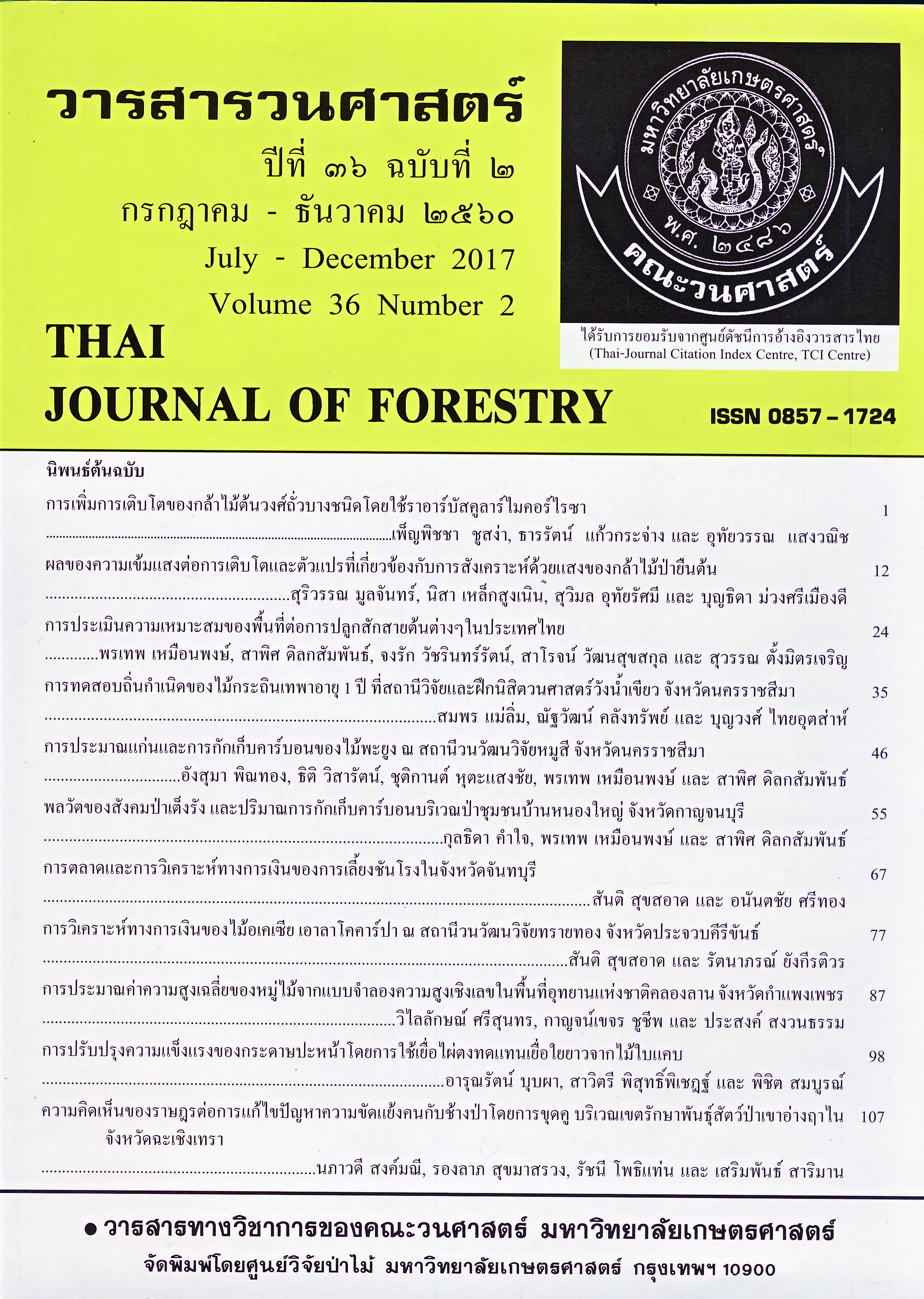การเพิ่มการเติบโตของกล้าไม้ต้นวงศ์ถั่วบางชนิดโดยใช้ราอาร์บัสคูลาร์ไมคอร์ไรซา
Main Article Content
บทคัดย่อ
การศึกษาครั้งนี้มีวัตถุประสงค์เพื่อศึกษาผลของราอาร์บัสคูลาร์ไมคอร์ไรซาต่อการเติบโตของกล้าไม้ต้นวงศ์ถั่ว ได้แก่ พะยูง ประดู่ป่า และแดง โดยนำ Acaulospora sp.1 และ Unknown sp.2 ซึ่งแยกสปอร์มาจากดินแปลงปลูกไม้วงศ์ถั่วทั้ง 3 ชนิดดังกล่าว หลังจากนำสปอร์ของราทั้ง 2 ชนิดไปปลูกเชื้อ (inoculate) ในกล้าข้าวโพดเพื่อผลิตเป็นหัวเชื้อ เป็นเวลา 3 เดือน แล้วจึงนำหัวเชื้อไปปลูกเชื้อให้แก่กล้าไม้พะยูง ประดู่ป่า และแดง ด้วยวิธีการปลูกเชื้อ 4 วิธี ได้แก่ (1) ปลูกเชื้อ Acaulospora sp.1 50 สปอร์, (2) ปลูกเชื้อ Unknown sp.2 50 สปอร์ (3) ปลูกเชื้อ Acaulospora sp.1 + Unknown sp.2 ชนิดละ 25 สปอร์ และ (4) ไม่ปลูกเชื้อ (control) ผลการศึกษาพบว่าหลังจากปลูกเชื้อให้แก่กล้าไม้อายุ 7 เดือน กล้าไม้มีร้อยละการเข้าอยู่อาศัยของราอาร์บัสคูลาร์ไมคอร์ไรซา ร้อยละ 13-55 ซึ่งการปลูกเชื้อด้วย Acaulospora sp.1 ทำให้กล้าไม้มีร้อยละการเข้าอยู่อาศัยของรามากที่สุด กล้าไม้ที่ปลูกเชื้อวิธีใดก็ตาม มีการเติบโตสัมพัทธ์ด้านความสูงและน้ำหนักแห้งมากกว่ากล้าไม้ที่ไม่ปลูกเชื้ออย่างมีนัยสำคัญทางสถิติ (P<0.05) ซึ่งการปลูกเชื้อด้วย Acaulospora sp.1 50 สปอร์ และ Acaulospora sp.1 + Unknown sp.2 ชนิดละ 25 สปอร์ สามารถทำให้กล้าไม้มีการเติบโตสัมพัทธ์ด้านความสูงและน้ำหนักแห้งมากกว่ากล้าไม้ที่ไม่ปลูกเชื้ออย่างมีนัยสำคัญทางสถิติ (P<0.05) โดยทั้งสองวิธีนี้สามารถนำไปใช้ในการเพิ่มการเติบโตให้กับกล้าไม้ได้โดยให้ผลไม่แตกต่างกัน
Downloads
Article Details
ข้าพเจ้าและผู้เขียนร่วม (ถ้ามี) ขอรับรองว่า ต้นฉบับที่เสนอมานี้ยังไม่เคยได้รับการตีพิมพ์และไม่ได้อยู่ในระหว่างกระบวนการพิจารณาตีพิมพ์ลงในวารสารหรือสิ่งตีพิมพ์อื่นใด ข้าพเจ้าและผู้เขียนร่วม (ถ้ามี) ยอมรับหลักเกณฑ์และเงื่อนไขการพิจารณาต้นฉบับ ทั้งยินยอมให้กองบรรณาธิการมีสิทธิ์พิจารณาและตรวจแก้ต้นฉบับได้ตามที่เห็นสมควร พร้อมนี้ขอมอบลิขสิทธิ์ผลงานที่ได้รับการตีพิมพ์ให้แก่วารสารวนศาสตร์ คณะวนศาสตร์ มหาวิทยาลัยเกษตรศาสตร์ กรณีมีการฟ้องร้องเรื่องการละเมิดลิขสิทธิ์เกี่ยวกับภาพ กราฟ ข้อความส่วนใดส่วนหนึ่ง หรือ ข้อคิดเห็นที่ปรากฏในผลงาน ให้เป็นความรับผิดชอบของข้าพเจ้าและผู้เขียนร่วม (ถ้ามี) แต่เพียงฝ่ายเดียว และหากข้าพเจ้าและผู้เขียนร่วม (ถ้ามี) ประสงค์ถอนบทความในระหว่างกระบวนการพิจารณาของทางวารสาร ข้าพเจ้าและผู้เขียนร่วม (ถ้ามี) ยินดีรับผิดชอบค่าใช้จ่ายทั้งหมดที่เกิดขึ้นในกระบวนการพิจารณาบทความนั้น”
เอกสารอ้างอิง
ณัฐวรางคณ์ สงวนราชทรัพย์. 2530. ชนิดและผลของเชื้อราเวสลิคูลา อาบัสคูลา ไมคอไรซา ต่อการเจริญเติบโตของกล้าไม้บางชนิด. วิทยานิพนธ์ปริญญาโท, มหาวิทยาลัยเกษตรศาสตร์.
ธารรัตน์ แก้วกระจ่าง, บารมี สกลรักษ์, อุทัยวรรณ แสงวณิช และเจษฎา วงศ์พรหม. 2558. การตอบสนองด้านการเติบโตของกล้าไม้พะยอม (Shorea roxburghii G. Don) ต่อการปลูกเชื้อเห็ดเผาะหนัง, น. 66-74. ใน การประชุมการป่าไม้ประจำปี พ.ศ. 2558. คณะวนศาสตร์, กรุงเทพฯ.
วีรวัตร นามานุศาสตร์. 2546. ความหลากหลายทางพันธุกรรมของเชื้อราอาบัสคูลาร์ไมคอร์ไรซาในกระถินเทพา. วิทยานิพนธ์ปริญญาโท, มหาวิทยาลัยเทคโนโลยีสุรนารี.
สำนักส่งเสริมการปลูกป่า. 2557. การส่งเสริมการปลูกป่า. กรมป่าไม้. กรุงเทพฯ.
Bray, R.H. and L.T. Kurtz. 1945. Determination of total organic and available form of phosphorus in soil. Soil Science 59: 39-45.
Brundrett, M., N. Bougher, B. Dell, G. Grove and N. Malajczuk. 1996. Working with Mycorrhizas in Forestry and Agriculture. ACIAR Monograph 32. ACIAR, Canberra.
Chaiyasen, A., J. Peter, W. Young, T. Neung, G. Pailboolya and S. Lumyong. 2014. Characterization of arbuscular mycorrhizal fungus communities of Aquilaria crassna and Tectona grandis roots and soils in Thailand plantations. PLOS ONE. 9 (11): 1-8.
Chiariello, N.R., H.A. Mooney and K. Williams. 1989. Growth, carbon allocation and cost of plant tissues, pp. 327-365. In R.W. Pearcy., J. Ehleringer., H.A. Mooney and P.W. Rundel., eds. Plant Physiological Ecology: Field Method and Instrumentation. Chapman and Hall, London.
Daniels, B.A. and H.D. Skipper. 1982. Methods for the recovery and quantitative estimation of propagules from soil, pp. 29-36. In N.C. Schenck., eds. Methods and Principle of Mycorrhizal Research. American Phytopathological. USA.
Gemma, J.K. and R.E. Koske. 1988. Pre-infection interactions between roots and the mycorrhizal fungus Gigaspora gigantea: chemotropism of germ tubes and root growth response. Transaction of the British Mycological Society 91: 123-132.
Hunt, R. 1990. Basic Growth Analysis: Plant Growth Analysis for Beginners. Unwin Hyman, London.
Jackson, M.L. 1965. Soil Chemical Analysis-Advance Course. Department of Soils, University of Wisconsin, USA.
Morton, J.B. and G.L. Benny. 1990. Revised classification of arbuscular mycorrhizal fungi (Zygomycocetes): A new order, Glomales, two new suborders, Glomineae and Gigasporineae, and two new families, Acaulosporaceae and Gigasporaceae, with an emeadation of Glomeceae. Mycotaxon 37: 471-491.
Oseni, T.O., N.S. Shongwe and M.T. Masarirambi. 2010. Effect of arbuscular mycorrhiza (AM) inoculation on the performance of tomato nursery seedlings in vermiculite. International Journal of Agriculture and Biology 12: 789-792.
Ptasad, K., A. Aggarwal, K. Yadav and A. Tanwar. 2012. Impact of different levels of superphosphate using arbuscular mycorrhizal fungi and Pseudomonas fluorescens on Chrysanthemum indicum L. Journal of Soil Science and Plant Nutrition 12 (3): 451-462.
Schenck, N. C. and Y. Perez. 1988. Manual for the Identification of VM mycorrhiza fungi. International Culture Collection of VA Mycorrhizal fungi (INVAM), Folida.
Seema, H. S. and R. H. Gerampalli. 2015. Effect of Arbuscular Mycorrhizal fungi on growth and biomass enhancement in Piper longum L. (Piperaceae). International Journal of Current Microbiology and Applied Sciences 4 (1): 11-18.
Smith, E.S. and D. Read. 2008. Mineral nutrition, toxic element accumulation and water relations of arbuscular mycorrhizal plants. Mycorrhizal Symbiosis. Academic Press, London.
Trouvelet, A., S. Gianinaazzi and V.Gianinazzi-Pearson. 1987. Screening of VAM fungi for phosphates tolerance under simulated field conditions, pp. 39. In D.M. Sylvia, L.L. Hung and J.H. Graham., eds. Mycorrhzae in the Next Decade: Practical Applications and Research Priorities. University of Florida, America.
West Virginia University. 2017. FLOURISHING FUNGI. Available Source: https://invam.wvu.edu/, May 26, 2017.


